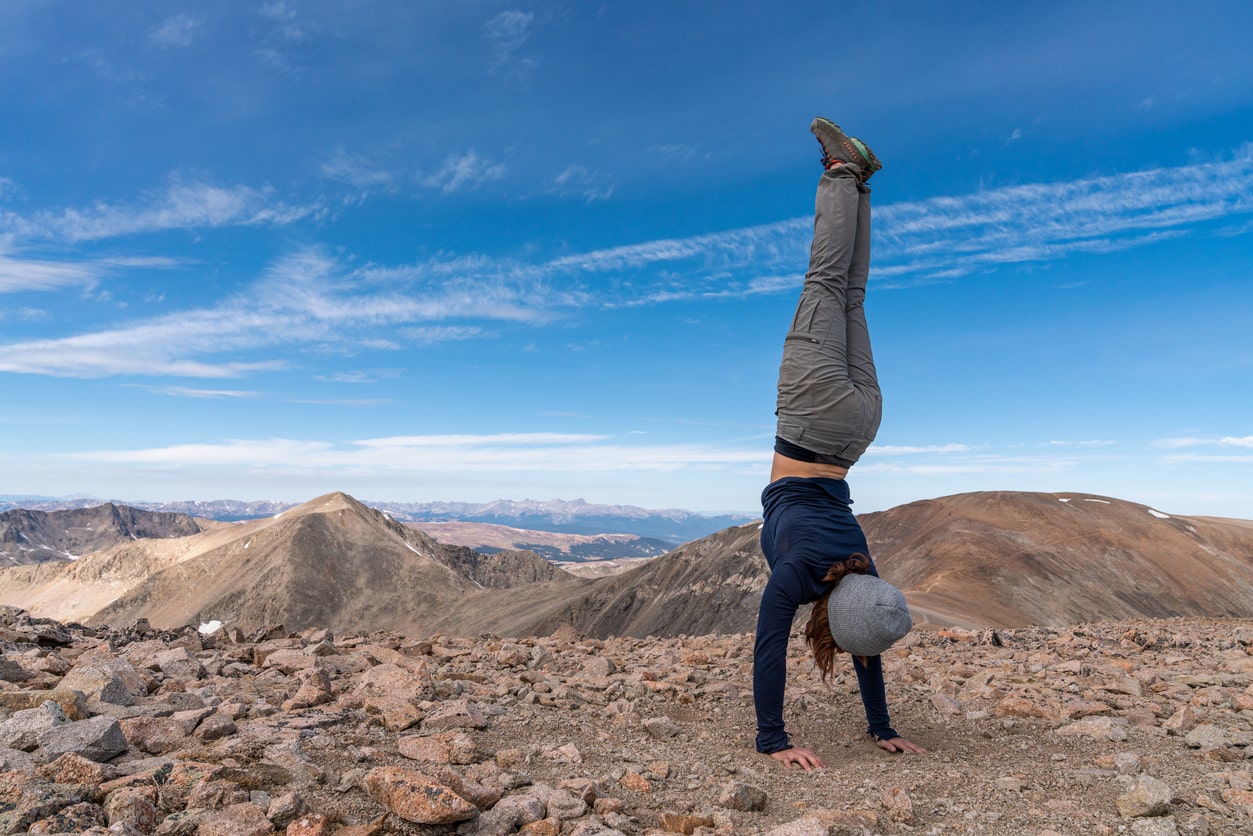How to Do a Handstand (for Beginners!)
Have you ever wondered how to do a handstand? You scroll through Instagram and see all these fitness-savvy models in yoga pants make it look so easy. So you give it a try. It’s easy, right!? So you bend over and try to kick your feet up, but it doesn’t compute, you get kinda stuck and your arms are wobbly, and you just fall over and give up. Definitely not an Instagrammable moment.
And you think to yourself: so how do they do it? Should I just give up? Is this a feat only achievable by people who regularly caption all their endless gym selfies with a paragraph of hashtags like “#gymlife”, “#fitnessmodel”, and “#selfiesdefinitelymakemeamodel”?
NO! Don’t give up! Anyone can do a handstand, and that means you! (And honestly, some people should probably calm down a little with those selfies and hashtags…)
While a handstand probably won’t happen overnight, there are three easy steps you can take to work your way up to a true handstand. It takes time, patience, and practice, as just about everything worthwhile does.
But when you finally nail your first handstand, you’ll be just as thrilled as Creed when he totally landed that ‘perfect’ cartwheel (but we’ll make sure you’re way more successful with your handstand):
It’s definitely worth it to give a handstand a solid try! Not only is it fun and a major sense of accomplishment (and how about that confidence boost!) to be able to whip out a handstand whenever and wherever you want, but it is also an excellent way to build and improve your upper body and core strength, balance, breathing, and focus. It also brings you an awareness and control over your body that can help increase your performance during other sports and exercise routines.
(But, as always, consult with a doctor or personal trainer before starting any new fitness endeavors.)
Here are 3 easy steps to take for how to do a handstand if you’re just beginning:
1. “L” handstand at a wall
2. Wall Kick-ups
3. Freestanding kick-up handstand
1. “L” handstand at a wall
The first step for how to do a handstand if you are just beginning is to begin with an “L” handstand against a wall.
Benefits
This L-shaped handstand against a wall is great for building up your upper body, arm, and core strength and just getting your body used to the feeling of being upside down. It also allows you to get a feel for proper alignment in your hands, wrists, elbows, and shoulders before getting more advanced.
What to do
Begin by facing a wall in a seated position with your legs stretched out together and feet against the wall. This helps give you a marker of how far away from the wall you need to start. Place any object as a marker where your hips are seated. This determines the distance from the wall to place your hands.
Now stand with your back to the wall, bend over, and place your hands palms down on the floor in front of you exactly shoulder-width apart at the marker’s distance. With your fingers spread and palms pressed to the ground, begin walking your feet up the wall until your legs are parallel with the floor and your hips are centered over your body, creating an “L” shape.
Hold this pose for about 30 seconds, or however long you feel comfortable. As soon as you feel your arms begin to weaken, walk your feet back down the wall and onto the floor to rest. You can make this pose more challenging by lifting one leg towards the ceiling, and then alternating with the other.
How many times
Do at least 5 sets of these, more if you feel strong enough. If you cannot hold the position for a full 30 seconds at a time, try breaking it down to 5 sets of 3 reps of holding for 10 seconds at a time.
2. Wall Kick-ups
The next step for how to do a handstand is to begin getting your body used to what a handstand feels like by kicking up into a handstand against a wall for support.
Benefits
Kicking up to a handstand against a wall further helps you gain a new level of strength in your upper body, arms, core, and engaging your hamstrings. Practicing against a wall helps get your body, mind, and equilibrium used to being fully upside down while providing stability. It also helps to conquer the fear of flipping over backward, as you always have the wall there for support.
What to do
Start with a standing forward bend (towards the wall this time) with your palms shoulder-width apart and flat on the floor at least 6 inches from the wall. Make sure your arms are not bent but form a straight line. Raise one leg in the air, then hop with the other one to propel your feet up in the air straight overhead and lightly land your heels on the wall. Then return to the ground, completing one rep. Repeat this a few times, switching the leg you hop with at each set.
When you feel strong and comfortable with your form, begin kicking up and trying not to touch the wall. Find your center and your balance, and hold this pose for as long as you can. Use it for balance as necessary, but start training yourself not to need it.
How many times
When working on kicking up each leg, do at least 3 sets of 5 reps with each leg (10 total). When you have enough strength and balance to kick all the way up, practice daily until you can begin to feel comfortable and stable without a wall.
3. Freestanding kick-up handstand
The final step for how to do a handstand for beginners is to move away from the wall and finally nail a freestanding kick-up handstand.
Benefits
Being able to execute a freestanding handstand gives you an incredible sense of accomplishment, confidence, and power throughout your body. It is an excellent way to build and improve your upper body and core strength, balance, breathing, and focus.
What to do
Begin in much the same way as the wall kickups, but this time in an open area. Start with the standing forward bend, palms shoulder-width apart and pressed to the floor with fingers spread and stable.
Raise one leg in the air, then hop the other leg up with progressively increasing force until you get your hips up directly above your shoulders. Keep your legs split, using small adjustments to find your balance here. Once balanced, slowly lift and bring your legs together, pointing straight up overhead until your body is in a line. Breathe in deep and focus, and hold for as long as you can.
Then bring yourself out of the pose and rest. Then congratulate yourself for accomplishing a handstand and reaching your goal!
How many times
Practice every day to build up your strength, balance, and comfort with this pose until you master it. A handstand is an accomplishment to be proud of in itself, but it is also just a starting point for even more levels of balance and strength poses and exercises for your body!
Love this content and want more? Read more sports and outdoors tips here! And don’t forget to subscribe to Dock Line Magazine for more great content like this sent straight to your email!





